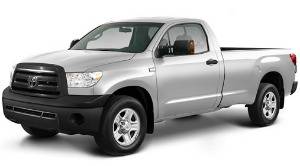Vehicle Type: Pickup truck
The Verdict Of The Used Toyota Tundra : Having the Tundra put on a hoist and looked at by a mechanic is key for confidence in getting a healthy used model. Issues with this truck seem to be easily identified and common, so a mechanic will be familiar with them. Careful and patient road testing with an open ear to “hear” any signs of trouble is also important.
Price: Prices span as widely as the Toyota Tundra’s available configurations. Expect to pay about $13,000 to $16,000 for a higher-mileage, earlier unit, and up to $50,000 for a slightly used 2013 model. There’s healthy selection in the $25,000 to $35,000 range for this model.
What Owners Like: The first word most owners put on their list of likes for this generation of Tundra? Power. Towing capacity, a quiet highway ride, overall comfort and smoothness, and looks round out the package. Some owners report good fuel mileage, which isn’t typical in a pickup review.
What Owners Dislike: Numerous Toyota Tundra owners reported a low budget, plastic-y interior, bouncy ride on rougher surfaces, and cheap factory tires. Some also found issues during parking exercises given the Tundra’s size and large turning circle.
History/Description: An updated Toyota Tundra pickup hits the market for the 2014 model year, meaning the second-generation 2007 to 2013 model has transitioned fully into used-truck territory.
This is the Tundra’s second generation, and it was available with numerous body and bed configurations, two- or four-wheel drive and standard V8 power, namely from a 4.7L or 5.7L unit.
Look for available leather seating, a premium stereo system, automatic climate control, a self-dimming rearview mirror, and more.
Common Issues With A Used Toyota Tundra: In earlier Toyota Tundra models, some owners reported a loud “slamming” noise from the rear of the truck, which could be caused by a faulty driveshaft spline. Some of these owners point at a Technical Service Bulletin issued by Toyota to address the problem (TSB-0115-08). A “growling” or “clunking” noise from the front differential area also indicates a problem.
So, be sure to listen to the Tundra you’re considering closely in a variety of driving conditions, and in particular at lower speeds while loading and unloading the driveline with throttle. Ensure no unwelcome sounds occur. If you’re suspicious, have a mechanic take a closer look. Note that these issues seemed to affect mostly earlier Tundra models.
While parked, wiggle the steering wheel of the Tundra you’re considering back and forth a half-turn or so. You’re listening for any popping or clunking sounds, which could indicate a problem with the power-steering rack. Other unwanted sounds could indicate a problem with CV joints or axles.
Water pumps tend to start leaking as a precursor to failure as the Tundra collects some miles, so be sure to ask the seller if the water pump is original. A leaking water pump will typically show itself with a small pink puddle after the vehicle has been parked, or a “dribble” down the body of the water-pump itself.
Other standard pickup truck checks apply, too. Ensure the Toyota Tundra you’re considering shifts from 2- to 4-wheel drive as outlined in the owner’s manual, check the condition of the tires and brakes, and have a look at the underside for signs of excessive rust or damage, possibly caused by careless off-roading.
The Verdict Of The Used Toyota Tundra : Having the Tundra put on a hoist and looked at by a mechanic is key for confidence in getting a healthy used model. Issues with this truck seem to be easily identified and common, so a mechanic will be familiar with them. Careful and patient road testing with an open ear to “hear” any signs of trouble is also important.
 |
| Photo: Matthieu Lambert |
Price: Prices span as widely as the Toyota Tundra’s available configurations. Expect to pay about $13,000 to $16,000 for a higher-mileage, earlier unit, and up to $50,000 for a slightly used 2013 model. There’s healthy selection in the $25,000 to $35,000 range for this model.
What Owners Like: The first word most owners put on their list of likes for this generation of Tundra? Power. Towing capacity, a quiet highway ride, overall comfort and smoothness, and looks round out the package. Some owners report good fuel mileage, which isn’t typical in a pickup review.
What Owners Dislike: Numerous Toyota Tundra owners reported a low budget, plastic-y interior, bouncy ride on rougher surfaces, and cheap factory tires. Some also found issues during parking exercises given the Tundra’s size and large turning circle.
History/Description: An updated Toyota Tundra pickup hits the market for the 2014 model year, meaning the second-generation 2007 to 2013 model has transitioned fully into used-truck territory.
This is the Tundra’s second generation, and it was available with numerous body and bed configurations, two- or four-wheel drive and standard V8 power, namely from a 4.7L or 5.7L unit.
Look for available leather seating, a premium stereo system, automatic climate control, a self-dimming rearview mirror, and more.
Common Issues With A Used Toyota Tundra: In earlier Toyota Tundra models, some owners reported a loud “slamming” noise from the rear of the truck, which could be caused by a faulty driveshaft spline. Some of these owners point at a Technical Service Bulletin issued by Toyota to address the problem (TSB-0115-08). A “growling” or “clunking” noise from the front differential area also indicates a problem.
So, be sure to listen to the Tundra you’re considering closely in a variety of driving conditions, and in particular at lower speeds while loading and unloading the driveline with throttle. Ensure no unwelcome sounds occur. If you’re suspicious, have a mechanic take a closer look. Note that these issues seemed to affect mostly earlier Tundra models.
While parked, wiggle the steering wheel of the Tundra you’re considering back and forth a half-turn or so. You’re listening for any popping or clunking sounds, which could indicate a problem with the power-steering rack. Other unwanted sounds could indicate a problem with CV joints or axles.
Water pumps tend to start leaking as a precursor to failure as the Tundra collects some miles, so be sure to ask the seller if the water pump is original. A leaking water pump will typically show itself with a small pink puddle after the vehicle has been parked, or a “dribble” down the body of the water-pump itself.
Other standard pickup truck checks apply, too. Ensure the Toyota Tundra you’re considering shifts from 2- to 4-wheel drive as outlined in the owner’s manual, check the condition of the tires and brakes, and have a look at the underside for signs of excessive rust or damage, possibly caused by careless off-roading.
 |
| Photo: Matthieu Lambert |




Article Gallery




